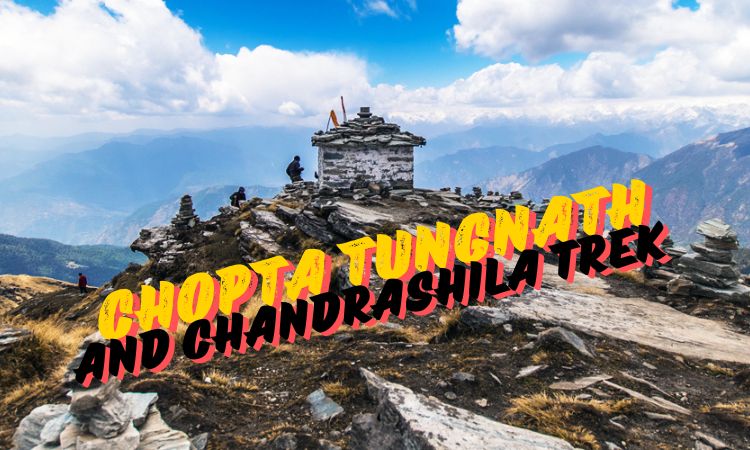
Nestled in the Garhwal Himalayas, the Chopta Tungnath and Chandrashila Trek beckons nature enthusiasts and spiritual seekers alike. This captivating journey unfolds amidst verdant meadows bursting with wildflowers, serene forests whispering secrets, and peaks piercing the azure canvas. As you traverse this path, you’ll encounter the sacred Tungnath Temple, perched proudly as the highest Shiva temple in the world, and ascend Chandrashila summit for a panoramic spectacle of the Himalayan giants.
Unveiling the Terrain: An Easy to Moderate Expedition
The Chopta Tungnath and Chandrashila Trek is graded as easy to moderate. The total distance covered is roughly 6-7 kilometers, with an elevation gain of about 1200 meters. The well-defined trails are suitable for beginners with a decent level of fitness. However, the climb from Tungnath to Chandrashila can be quite steep, especially during winters when the path is blanketed in snow. Make sure you have proper gear and are acclimatized to the altitude before attempting this section.
Embarking on the Journey: A Step-by-Step Guide
The trek typically commences from Sari village, a quaint hamlet nestled amidst verdant beauty. From here, you can hire a taxi or take a shared jeep to Chopta, also known as Mini Switzerland for its resemblance to the European nation’s meadows.
Day 1: Sari Village to Chopta (3 kilometers)
The first day is a gentle introduction to the Himalayas. The trail winds through verdant meadows carpeted with vibrant wildflowers like rhododendrons in summer. Keep your eyes peeled for fascinating birds like the Himalayan Monal, known for its stunning plumage. As you reach Chopta, settle into your guesthouse and savor the breathtaking vistas of the surrounding peaks like Nanda Devi, Trishul, and Chaukhamba.
Day 2: Chopta to Tungnath (4 kilometers)
Day two marks the ascent towards the spiritual realm. The trail from Chopta to Tungnath is a well-laid concrete path, offering stunning views of the valley below. Breathe in the crisp mountain air and soak in the serenity as you walk amidst verdant meadows. After a pleasant hike, you’ll arrive at Tungnath, perched at a staggering height of 3680 meters.
Tungnath: Abode of Lord Shiva
Tungnath boasts the highest Shiva temple in the world. This ancient edifice, constructed in a distinctive architectural style, exudes a sense of peace and tranquility. Take a moment to offer prayers or simply admire the intricate carvings and the breathtaking backdrop of the Himalayas. Here, you can stay overnight in guest houses or the temple premises, experiencing the unique charm of the high Himalayas.
Day 3: Tungnath to Chandrashila and Back (3 kilometers)
The summit push to Chandrashila is the highlight of the trek. Begin your ascent early in the morning to witness the magical sunrise paint the mountains in hues of orange and pink. The trail from Tungnath to Chandrashila is a steeper section, especially during winters when snow covers the path. Proper footwear and trekking poles are essential for this part of the trek.
Chandrashila: A Realm of Panoramic Vistas
Upon reaching Chandrashila, a small temple dedicated to Lord Ganesha awaits. But the true reward lies beyond. The summit offers a breathtaking 360-degree panorama of the majestic Himalayan peaks. Nanda Devi, the second-highest mountain in India, stands tall amidst its companions, creating a picture-perfect vista. Savor this moment, etching the grandeur of the Himalayas in your memory.
After capturing the essence of the mountains, descend back to Tungnath and continue your journey down to Chopta. The descent is a relatively easier affair, allowing you to admire the landscape at a leisurely pace.
Day 4: Chopta to Sari Village (3 kilometers)
The final day involves a leisurely walk back to Sari village. Reflect on the memories you’ve created, the challenges you’ve overcome, and the beauty you’ve witnessed. This trek is more than just a physical journey; it’s a chance to reconnect with nature, experience the serenity of the Himalayas, and discover your inner strength.
Beyond the Trail: Exploring the Environs
If you have additional time, consider exploring the following:
- Deoriatal Lake: Nestled amidst dense forests, Deoriatal Lake offers a serene escape. Take a boat ride on the pristine waters or simply relax on the banks, soaking in the tranquility.
- Ukhimath: This charming town, known as the “Winter Home of Lord Shiva,” boasts ancient temples and a laid-back atmosphere. Immerse yourself in the local culture and explore the hidden gems of the region.
Planning Your Chopta Tungnath and Chandrashila Trek: Essential Tips
Season:
- Best Time: The ideal time to embark on the Chopta Tungnath and Chandrashila Trek is between May and June, and September to November. These months offer pleasant weather with clear skies and vibrant wildflowers.
- Winter Trek: During winters (December to February), the landscape transforms into a winter wonderland. However, the trails can be slippery due to snow, and the climb to Chandrashila becomes more challenging. Proper winter gear and experience are essential for a winter trek.
Fitness:
While the trek is graded as easy to moderate, a basic level of fitness is recommended. Regular walks or jogs in the weeks leading up to the trek will prepare you for the climbs.
Accommodation:
- Chopta: Guesthouses and lodges are available in Chopta, offering comfortable accommodation with basic amenities.
- Tungnath: Here, you can stay overnight in guest houses or the temple premises. The experience of staying at the highest Shiva temple is unique and offers breathtaking views.
Permits:
No specific permits are required for the Chopta Tungnath and Chandrashila Trek. However, it’s advisable to register yourself at the Forest Check Post in Sari village.
Gear:
- Clothing: Pack comfortable hiking clothes, a waterproof jacket, thermals for colder temperatures (especially for mornings and evenings), and a hat.
- Footwear: Sturdy hiking boots with good ankle support are essential.
- Backpack: Carry a comfortable backpack with enough space for essentials like water, snacks, a raincoat, sunscreen, and a first-aid kit.
- Other Essentials: Sunglasses, sunscreen, a hat, a water bottle, a camera, and a headlamp are recommended.
Guides and Porters:
Hiring a guide is not mandatory but can be beneficial, especially for first-time trekkers. They can provide valuable insights into the region, navigate the trails, and ensure your safety. Porters can be hired to carry your luggage, making the trek more comfortable.
Respecting the Environment:
- Leave No Trace: Practice responsible tourism by minimizing your impact on the environment. Pack out all your trash and avoid littering.
- Respect Local Customs: Dress modestly when visiting temples and be mindful of local customs and traditions.
Safety:
- Acclimatization: Spend a day or two in Chopta to acclimatize to the high altitude before embarking on the trek.
- Stay Hydrated: Drink plenty of water throughout the trek to avoid dehydration.
- Be Aware of Altitude Sickness: Watch out for symptoms of altitude sickness like headaches, dizziness, and nausea. Descend immediately if you experience any discomfort.
- Respect the Weather: Be prepared for sudden changes in weather conditions.
By following these tips and planning meticulously, you can ensure a safe, enjoyable, and unforgettable experience on the Chopta Tungnath and Chandrashila Trek.
Chopta Tungnath & Chandrashila Trek FAQs
1. What is the difficulty level of the Chopta Chandrashila trek?
Ans. The Chopta Chandrashila trek is considered an easy to moderate trek. The total distance is around 9 kilometers, but the incline can be challenging at times.
2. What is the best time to do the Chopta Chandrashila trek?
Ans. The ideal trekking season is from May to June and September to November. During these months, you’ll experience pleasant weather and clear mountain views. Winter offers stunning snowy landscapes but requires proper winter trekking gear and experience.
3. What is the altitude of Chandrashila and Tungnath?
Ans. Chandrashila peak sits at an elevation of 4,000 meters, while Tungnath temple is located at 3,600 meters.
4. How long does the Chopta Chandrashila trek take?
Ans. The trek from Chopta to Tungnath can take 2-3 hours, and another hour to reach Chandrashila from Tungnath. The total time depends on your fitness level and pace.
5. Is a guide necessary for the Chopta Chandrashila trek?
Ans. While not mandatory, especially for experienced trekkers, a guide can enhance your experience. They can navigate the trail, share local knowledge, and ensure your safety.
6. What are the accommodation options available during the trek?
Ans. Guest houses and lodges are available in Chopta, where you can stay before and after the trek. Campsites are also set up near Tungnath temple for a more rustic experience.
7. What should I pack for the Chopta Chandrashila trek?
Ans. Pack comfortable hiking shoes, breathable clothing, a raincoat, a warm jacket (especially for mornings and evenings), sunglasses, sunscreen, a hat, and a backpack.
8. Do I need a permit for the Chopta Chandrashila trek?
Ans. Currently, no permits are required for the Chopta Chandrashila trek. However, it’s always a good idea to check with local authorities for any updates.
9. Is there mobile network connectivity during the trek?
Ans. Connectivity may be limited, especially on the higher reaches. It’s advisable to inform someone about your trek itinerary and have a power bank to keep your phone charged for emergencies.
10. What are the food options available during the trek?
Ans. Limited food stalls are available along the trail offering basic snacks and tea. It’s wise to carry some high-energy snacks like nuts, fruits, and energy bars for the trek.


